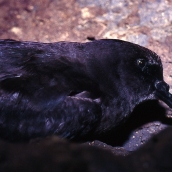Bulwer’s Petrel (Bulweria bulwerii)
This pelagic seabird measures from 25-29 cm in total length, wingspan from 67-73 cm. Plumage almost entirely blackish-brown, with paler dorsal wingbars. The tail is long and the tip is wedge-shaped. Like other birds of the same order, the bill has tubular external nostrils and the feet are webbed. Macaronesia is one of the main distribution areas in the world for this species, which breeds on all the island groups (the Azores, Madeira, Savage, Canaries and Cape Verde). It forms colonies on coastal rocks and islets, on debris at the bottom of crumbling cliffs and slopes on the main islands, but rarely breeds inland. It is fully adapted to the open sea, which is its home environment. It feeds on fish, cephalopods and crustaceans, plunge-diving to catch its prey. A clutch of a single egg (also true of other birds of the same order) is laid in Madeira, the Savage Islands and the Canaries from late May to early June. The egg hatches in July and the fledgling leaves the nest in mid September. In Cape Verde, however, clutches have been found between January and May, and nestlings from June to September. This petrel occupies rock cavities and crevices, rocky outcrops and stone walls, as well as hollows in sandy earthy soils—or roosts of the white-faced storm-petrel (Pelagodroma marina)—or under small shrubs. At the end of the breeding season, in September, Bulwer’s petrel heads for the waters of South America, returning to its colonies from April onwards, or occasionally as early as March or February. Sightings have been recorded in North America, West Africa, the South Atlantic and Europe. Its main colonies in Macaronesia are found in the Desertas (Madeira) and Savage Islands, and the Roques de Anaga (Tenerife, Canary Islands). It is relatively common in this environment, except in the Azores and Cape Verde, but is threatened by several factors, including predation by cats, rodents and seagulls, uncontrolled human visits to its colonies and intrusive light or glare in coastal areas. Populations have been estimated at around 7,500-9,000 pairs in this sector of the Atlantic.













